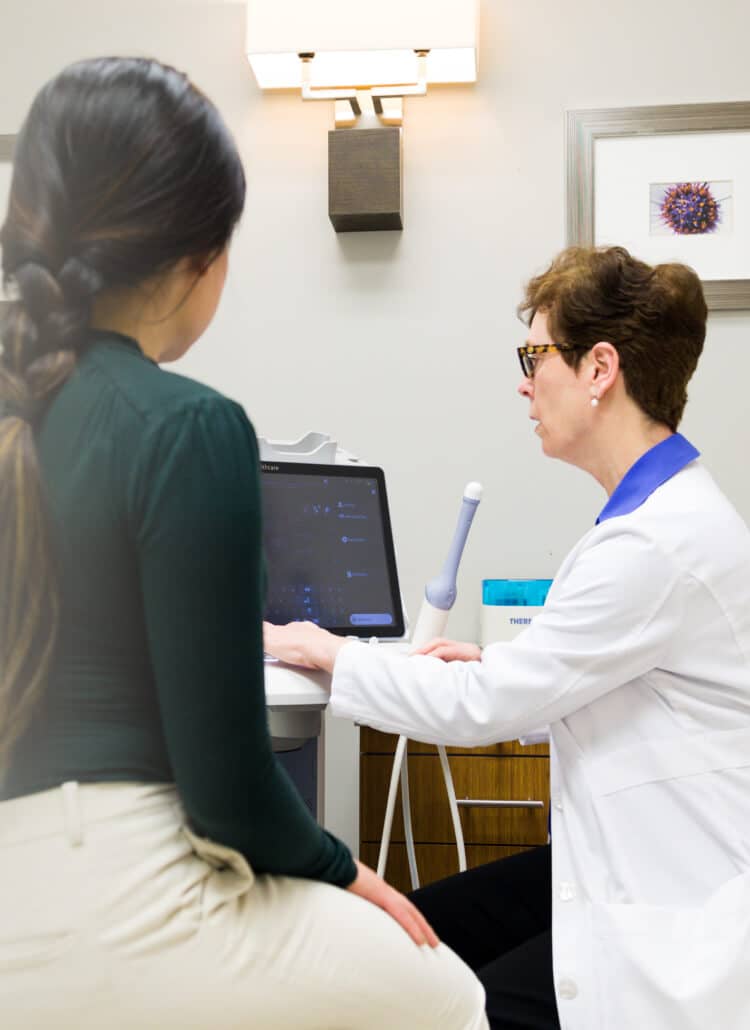Learn about hydrosalpinx symptoms & causes, in addition to hydrosalpinx treatment options currently available
Hydrosalpinx is the medical name for a fallopian tube that has become filled with fluid due to injury or infection. The fallopian tubes normally function to 'catch' an egg each month as it is released from the ovary; the tubes are the meeting place for egg and sperm and the mechanism by which the fertilized egg travels to the uterus. Damage to this tiny, delicate passageway can inhibit conception and pregnancy. Hydrosalpinx usually affects both fallopian tubes, (even when only one tube is affected, there is usually some residual damage to the other). Hydrosalpinges (when both tubes are affected) is a very severe form of tubal damage and pregnancy is usually only achieved with In Vitro Fertilization. IVF bypasses the tubes altogether.
Hydrosalpinx Causes
Hydrosalpinx commonly results from a long-untreated infection in the fallopian tubes. A number of situations may lead to fallopian tube infection, including:
- The residual effects of a prior sexually transmitted disease such as chlamydia or gonorrhea
- Prior ruptured appendix
- Excessive tissue buildup due to endometriosis
The inflammation and healing process resulting from such infection destroys the delicate finger-like fimbria, which extend from the end of the fallopian tube to the ovary. Fimbria are responsible for carrying the egg to waiting sperm and moving egg and sperm together for fertilization. When injured, fimbria become fused together, thus closing off the tubes. Fluid then collects in the fallopian tubes, making it impossible for them to function.
Ready for an Appointment in the Bay Area?
If you're ready to explore treatment, contact the award-winning team at Pacific Fertility Center.
Find a Prelude Fertility Clinic Location Near You
The Prelude Network is the fastest-growing network of fertility centers in North America.
Diagnosing Hydrosalpinx
There are several ways to diagnose a hydrosalpinx. Because fallopian tubes are very tiny, all of these methods use some form of X-ray or camera to clearly view the anatomy:
Ultrasound
In this procedure, a narrow probe is inserted into the vagina. Ultrasound technology uses sonar or high frequency sound waves to produce a real-time image of the fallopian tubes. A normal fallopian tube is usually not visible on an ultrasound; a tube filled with fluid will appear larger and 'sausage-shaped.' Ultrasound is brief, non-invasive and painless, and is often used in the initial assessment of the ovaries, uterus and fallopian tubes.
Hysterosalpingogram (HSG)
This is an X-ray exam, during which a small amount of dye is injected into the uterus and fallopian tubes. The X-ray is viewed on a screen as the exam is conducted. As the dye disperses through the uterus, any blockages will be easy to visualize. If the fallopian tubes are open, the fluid flows through the tubes and spills into surrounding abdominal area. In the event of a blockage such as a hydrosalpinx, dye is unable to exit the fallopian tubes, and tubes will appear distended ('sausage shaped'). HSG is performed in the 2nd week of the menstrual cycle (i.e. after menstrual bleeding has stopped but before ovulation). The entire exam takes about 10 minutes. Side effects, if any, may involve pelvic pain or cramping. Ibuprofen taken prior to the procedure helps with these possible side effects. Most women can resume daily activities right away.
Laparoscopy
This is a surgical procedure using a laparoscope -- a thin, lighted instrument fitted with a tiny viewing camera. The laparoscope is inserted into the pelvic area via a tiny incision in the belly button, enabling the surgeon to directly see the fallopian tubes on a screen. In certain cases, laparoscopy may be used to confirm a previous diagnosis of hydrosalpinx or other conditions; but because it is a surgical procedure requiring general anesthesia, it is generally not used for an initial diagnosis.
Hydrosalpinx Treatment
Repair
In some cases, especially where the hydrosalpinx is small, this type of blockage can be repaired, allowing pregnancy to occur naturally. This requires a surgical procedure called neosalpingostomy, in which a laparoscope is surgically inserted into the abdomen and an incision is made to open the blocked fallopian tube. Recovery from this procedure is relatively rapid and normal activity may be resumed within a few days. Because ovarian health and egg quality decline after the age of 35, reversal surgery is more viable for younger patients who can afford the additional wait time. Patients conceiving after tubal surgery must be monitored very closely for a possible ectopic pregnancy. This is a potentially serious situation in which the fetus implants and grows in the fallopian tube instead of the uterus.
Because of the low changes of success with attempts at surgical reconstruction of the tubes (some studies have shown a 10% pregnancy rate in the year following neosalpingostomy for hydrosalpinges), and because of the increased risk of ectopic pregnancy, most women experiencing significant tubal damage are advised to move directly to IVF.
In Vitro Fertilization (IVF)
In patients with hydrosalpinx, the fallopian tubes can be bypassed entirely using IVF treatment. This treatment involves a course of fertility enhancing medication to produce multiple eggs in the ovaries. Eggs are then 'harvested,' or removed from the ovaries and combined with the male sperm in the laboratory. The newly fertilized egg is then transferred directly into the woman's uterus via a small tube called a catheter.
In order to increase IVF success and a healthy pregnancy, it may be recommended that the damaged portion of the fallopian tube be removed entirely before treatment, as in some cases, fertility enhancing drugs may have the adverse effect of causing fluid buildup in the fallopian tubes. Blocked, fluid-filled tubes also can leak into the uterus, posing a risk of infection after embryo transfer.



